10 Unique Bedding Plants Beyond Pansies And Begonias


Elizabeth is a Permaculture Garden Designer, Sustainability Consultant and Professional Writer, working as an advocate for positive change. She graduated from the University of St. Andrews with an MA in English and Philosophy and obtained a Diploma in Applied Permaculture Design from the Permaculture Association.
Reviewed By PETER LICKORISH

Peter is a Horticulture Lecturer and self-employed Horticulturist, with a passion for diverse areas of the industry - from garden design to the science behind plant growth and propagation. He has completed the Royal Horticultural Society’s Master of Horticulture (MHort) Award and lectures on RHS courses at Bedford College.
Bedding plants are used to create displays in a garden for a particular season of interest.
Bedding displays became popular during Victorian times and they are still a common feature in public gardens.1Hopper, B. (2021, March 23). Digital Traineeship Blog: Postcards, Public Parks and Carpet Bedding. Garden Museum. Retrieved March 13, 2023, from https://gardenmuseum.org.uk/digital-traineeship-blog-postcards-public-parks-and-carpet-bedding/
Bedding plants are also popular with home gardeners seeking to create attractive beds, borders, containers or hanging baskets.
Typical bedding plants are extremely popular in the UK, accounting for a large proportion of gardener spending, but which plants you choose, and how you start out with your planting can have a big impact on the aesthetic success of the scheme.
The decisions you take will also have a big impact on how sustainable and eco-friendly your gardening efforts will be.
Bedding plants are frequently purchased as plugs or young plants.
However, it can be a greener option to grow your own bedding plants from seed or cuttings.
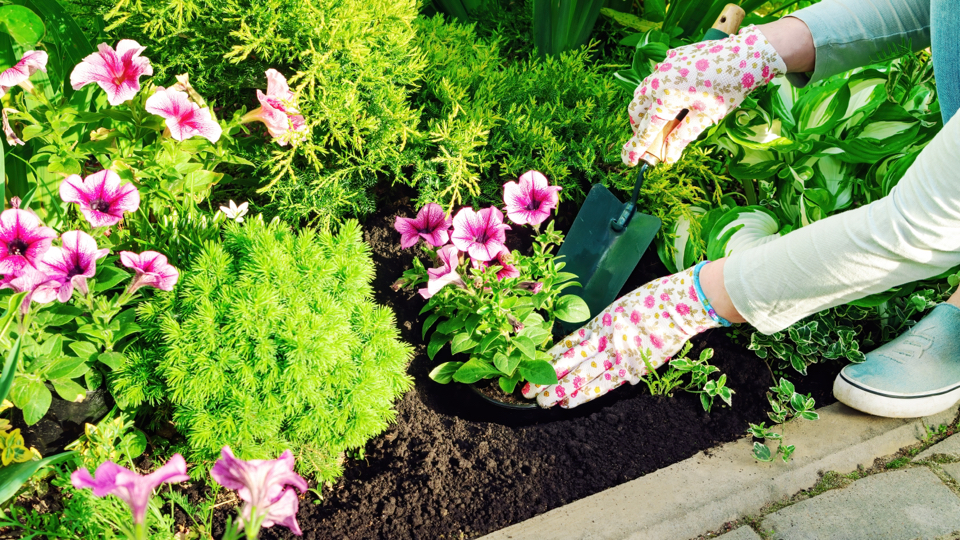
Taking a more DIY approach can help you avoid contributing to harmful horticultural industry practices, avoid peat, and reduce plastic use in your garden.
Thinking beyond pansies and begonias and other common bedding plants and considering more interesting and unusual options could help your garden to stand out, and help you create a more contemporary scheme.
Below are 10 suggestions to help you choose bedding plants suited to both winter and summer displays.
Of course, these are just a few of my personal suggestions, but they may help you in creating your own beautiful bedding displays.
Winter-Spring Bedding Displays
Commonly, winter bedding plants chosen for displays will include tried and tested favourites like violas, pansies, polyanthus and primroses.
Another more interesting option to consider are foliage plants and shrubs.
Here are 3 of my favourites:
1) Erica carnea
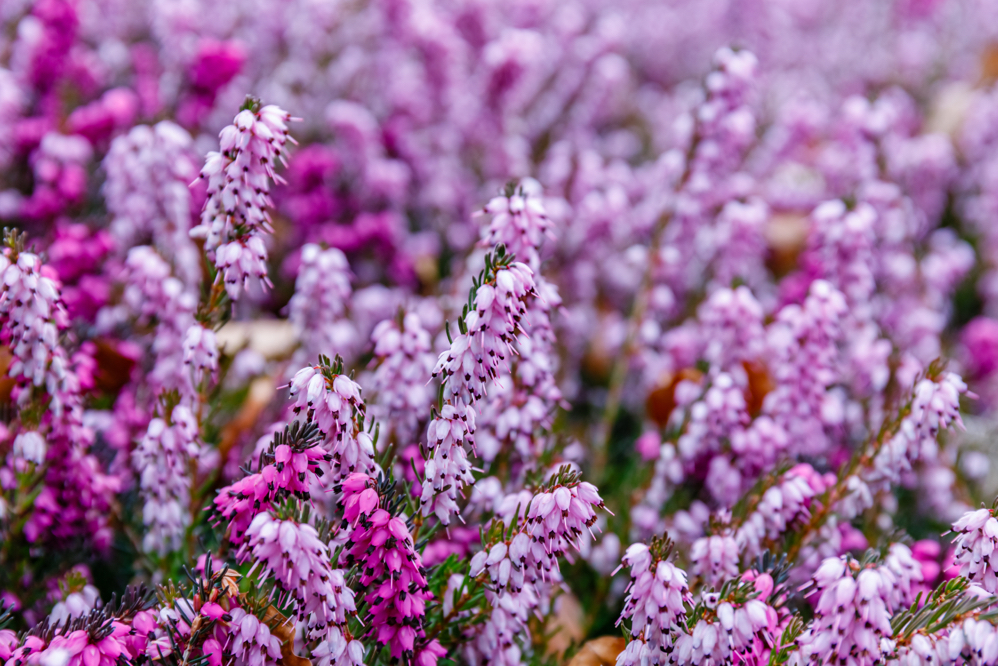
- COMMON NAME(S): Alpine Heath
- HARDINESS RATING: H6
- PLANT TYPE: Perennial shrub
- FOLIAGE TYPE: Evergreen
- FLOWERS: Pink, purple and white
- FLOWERING SEASON(S): Winter / Spring
- SUNLIGHT: Full Sun / Partial Shade
- EXPOSURE: Exposed / Sheltered
- SOIL PREFERENCE: Clay, loam, sand; any pH
- SIZE: 0.1-0.5m in height, 0.5-1m spread
One of our top picks for a winter display is Erica carnea.
This winter-flowering, perennial heather will be valuable for bees and will look great throughout the winter months.
2) Brassica oleracea
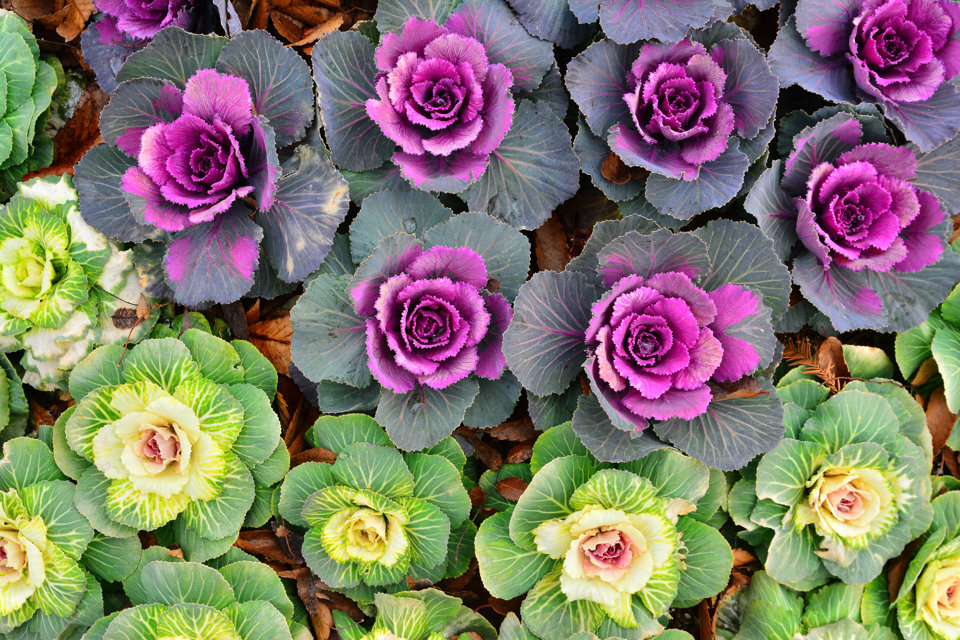
- COMMON NAME(S): Ornamental Cabbage
- HARDINESS RATING: H7
- PLANT TYPE: Vegetable
- FOLIAGE TYPE: Evergreen
- FLOWERS: Yellow
- FLOWERING SEASON(S): Summer / Autumn
- SUNLIGHT: Full Sun / Partial Shade
- EXPOSURE: Exposed / Sheltered
- SOIL PREFERENCE: Any soil type; alkaline / neutral pH
- SIZE: 1-1.5m in height, 0.1-0.5m spread
Hardy biennials are popular for summer displays, but some are also ideal for a winter display.
Another of our top picks for winter bedding displays are ornamental brassicas.
Kales and cabbages, with interesting foliage in greens and purples and pinks, will look wonderful in a display over the coldest months.
We’ve been specific and chosen to go with Brassica oleracea, pictured above, as this ornamental cabbage is bound to add delight to your winter displays.
“‘Nagoya Red’ has ruffled leaves and a purple centre,” adds Master Horticulturist Peter Lickorish.
3) Chionodoxa luciliae Boiss.
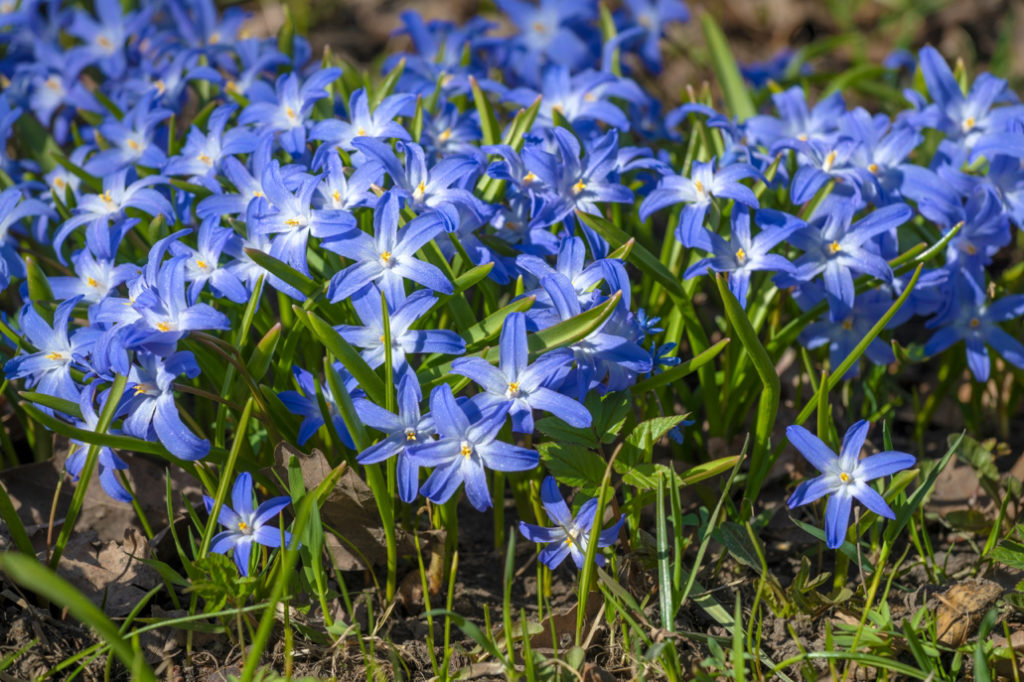
- COMMON NAME(S): Lucile’s glory of the snow
- HARDINESS RATING: H6
- PLANT TYPE: Perennial
- FOLIAGE TYPE: Deciduous
- FLOWERS: Blue and white
- FLOWERING SEASON(S): Spring
- SUNLIGHT: Full Sun / Partial Shade
- EXPOSURE: Exposed / Sheltered
- SOIL PREFERENCE: Any soil type; any pH
- SIZE: 0.1-0.5m in height, 0-0.1m spread
Bulbs are invaluable in creating late winter and early spring colours in bedding displays.
They’re also sold under the botanical name Scilla.
There are plenty of early spring bulbs to consider, including snowdrops, crocus, narcissus, anemones, and grape hyacinths.
Our top pick for winter bedding displays however is ‘Glory of the Snow’, especially because of the vibrancy of the blue flowers
These can be particularly effective in carpet-style bedding displays early in the year.
Summer Bedding Displays
Summer bedding displays offer, of course, even more exciting options.
4) Tagetes patula
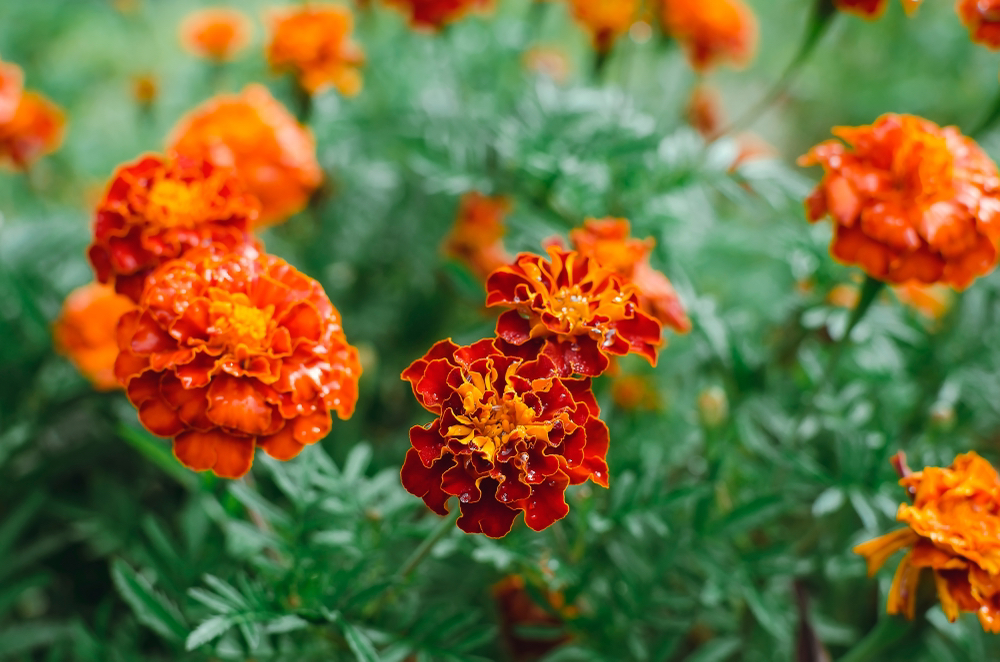
- COMMON NAME(S): French marigold
- HARDINESS RATING: H2
- PLANT TYPE: Annual
- FOLIAGE TYPE: Deciduous
- FLOWERS: Yellow, orange, red and brown
- FLOWERING SEASON(S): Summer / Autumn
- SUNLIGHT: Full Sun
- EXPOSURE: Exposed / Sheltered
- SOIL PREFERENCE: Clay, loam, sand; any pH
- SIZE: 0.1-0.5m in height, 0.1-0.5m spread
Many half-hardy annuals are amongst the most popular bedding plants for summer displays.
Cosmos, Nemesia and Nicotiana are just some of the popular options.
One of our favourites is the French marigold, which looks beautiful en mass and provides a range of benefits to pollinators, other plants and wildlife in your garden.
5) Calendula officinalis
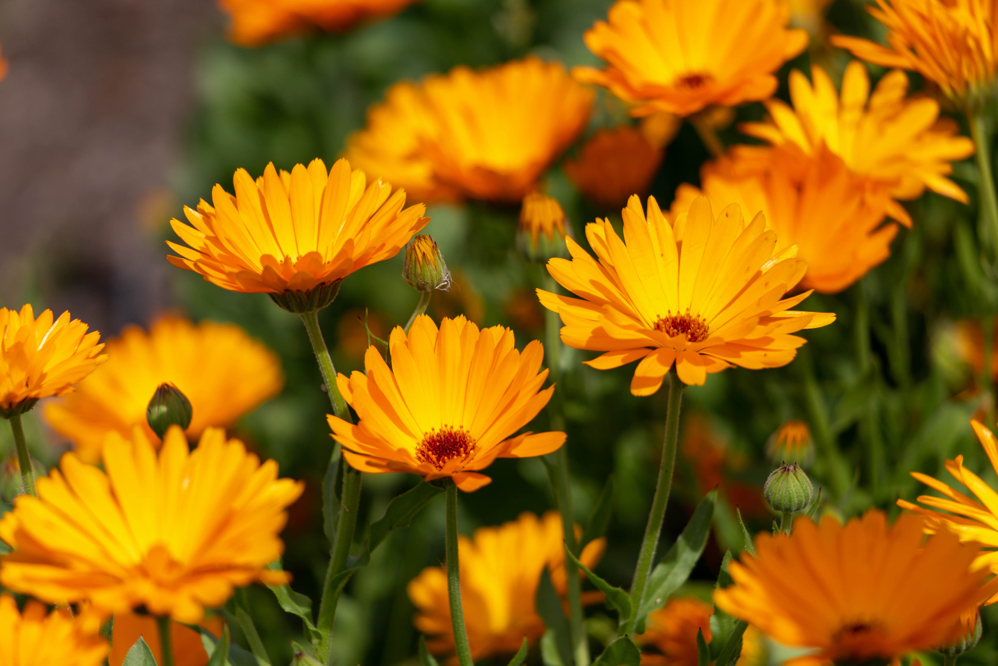
- COMMON NAME(S): Common marigold
- HARDINESS RATING: H5
- PLANT TYPE: Annual / biennial
- FOLIAGE TYPE: Deciduous
- FLOWERS: Orange
- FLOWERING SEASON(S): Summer / Autumn
- SUNLIGHT: Full Sun / Partial Shade
- EXPOSURE: Exposed / Sheltered
- SOIL PREFERENCE: Chalk, loam, sand; any pH
- SIZE: 0.1-0.5m in height, 0.1-0.5m spread
There is also a range of hardy annuals which can be sown directly into your garden in spring.
There are many options to consider, including Alyssum, Iberis and Limnanthes.
One great choice is Calendula (pot marigold).
This is wonderful for bees and other pollinators, should also help attract other beneficial insects to your garden, and looks great over a long blooming period.
6) Myosotis sylvatica
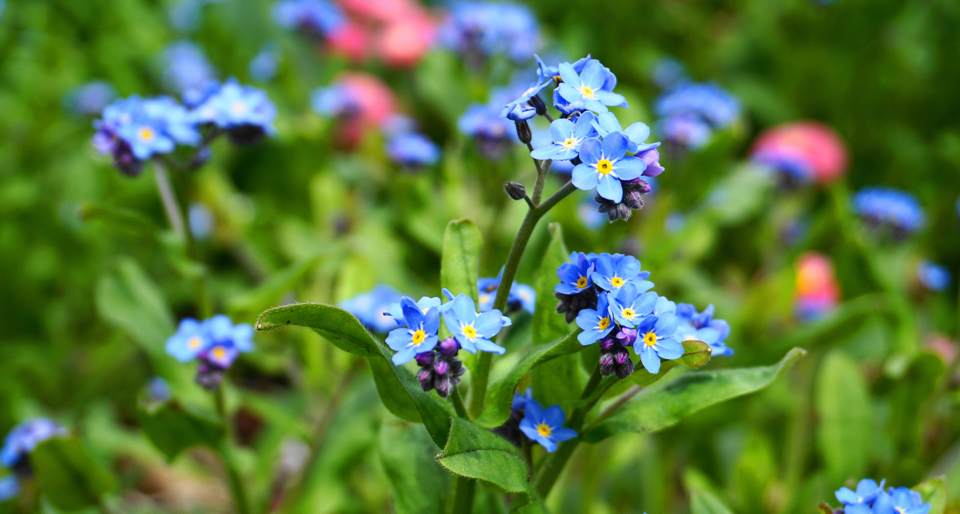
- COMMON NAME(S): Garden forget-me-not
- HARDINESS RATING: H6
- PLANT TYPE: Perennial
- FOLIAGE TYPE: Semi-Evergreen
- FLOWERS: Blue
- FLOWERING SEASON(S): Spring / Summer
- SUNLIGHT: Partial Shade
- EXPOSURE: Exposed / Sheltered
- SOIL PREFERENCE: Chalk, loam, sand; any pH
- SIZE: 0.1-0.5m in height, 0.1-0.5m spread
Over the summer months, biennials can also make great bedding plants for displays.
“Forget-me-not is often treated as a biennial, sown in summer for flowers the following spring,” shares Peter.
Hollyhocks, Dianthus, and Erisymum are three popular biennials.
One bedding plant I’d like to highlight is Myosotis, more commonly known as forget-me-nots.
Forget-me-nots are another excellent option for carpet bedding, producing beautiful blue flowers in spring and summer.
They also look wonderful in pots or containers in the garden.
7) Salvia splendens
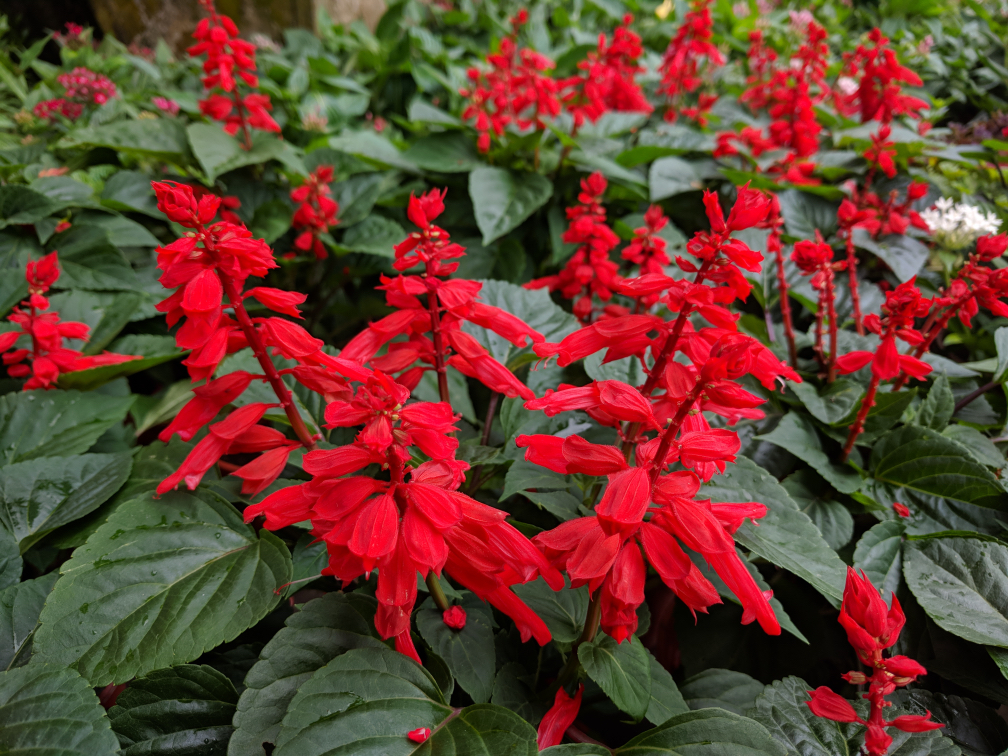
- COMMON NAME(S): Scarlet sage
- HARDINESS RATING: H3
- PLANT TYPE: Perennial / annual
- FOLIAGE TYPE: Deciduous
- FLOWERS: Red
- FLOWERING SEASON(S): Summer / Autumn
- SUNLIGHT: Full Sun
- EXPOSURE: Exposed / Sheltered
- SOIL PREFERENCE: Loam or sand; any pH
- SIZE: 0.1-0.5m in height, 0.1-0.5m spread
Many half-hardy perennials are grown in bedding schemes as annuals.
Well-known examples include Begonias, Geraniums, busy Lizzies, summer pansies and Lobelia.
One which can be a great choice for summer displays is Salvia splendens.
Salvias bloom later in the summer and into early autumn and are another great choice for summer bedding displays.
They can be combined with other flowers for formal schemes, or with beautiful ornamental grasses and other flowering perennials for bedding displays with a more informal look.
8) Tulipa
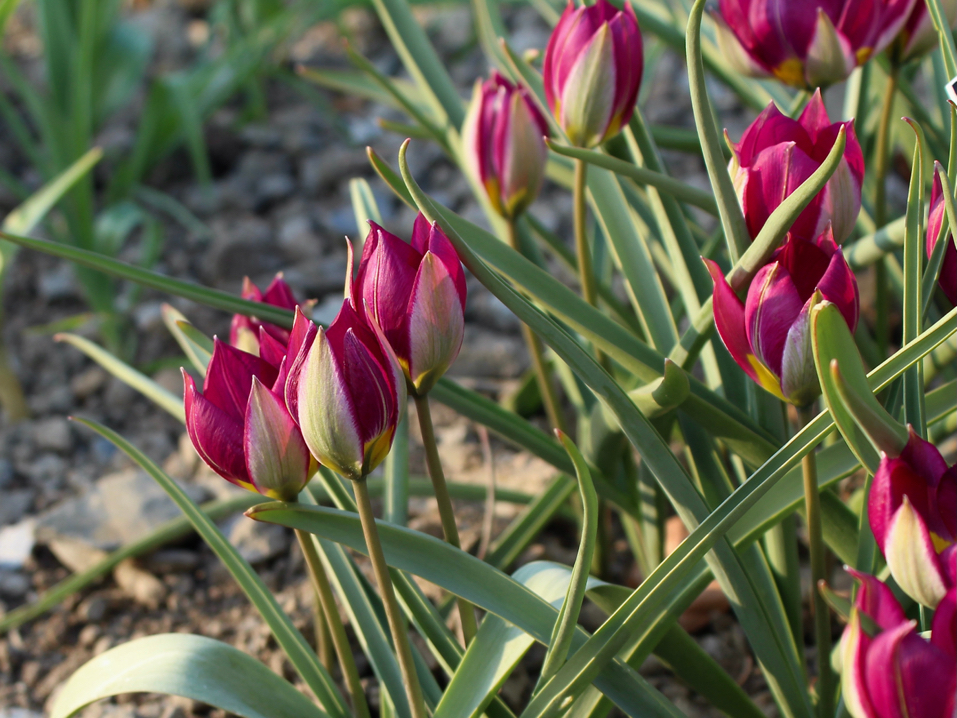
- COMMON NAME(S): Tulip
- HARDINESS RATING: H6
- PLANT TYPE: Perennial
- FOLIAGE TYPE: Deciduous
- FLOWERS: Varies
- FLOWERING SEASON(S): Spring / Summer
- SUNLIGHT: Full Sun / Partial Shade
- EXPOSURE: Exposed / Sheltered
- SOIL PREFERENCE: Clay, loam, sand; any pH
- SIZE: 0.1-0.5m in height, 0-0.1m spread
Summer bedding schemes often start with spring flowering bulbs, which oversee the transition between winter and summer plantings.
Hyacinths and alliums are common choices, but perhaps one of the best-known and best-loved bedding plants is the tulip.
Tulips, of course, come in a huge range of colours and types, and no matter what type of bedding display you wish to create, mass plantings of tulips can often be a major hit.
This may be a tried and tested favourite, but it is one which has stood the test of time.
9) Sedum spectabile
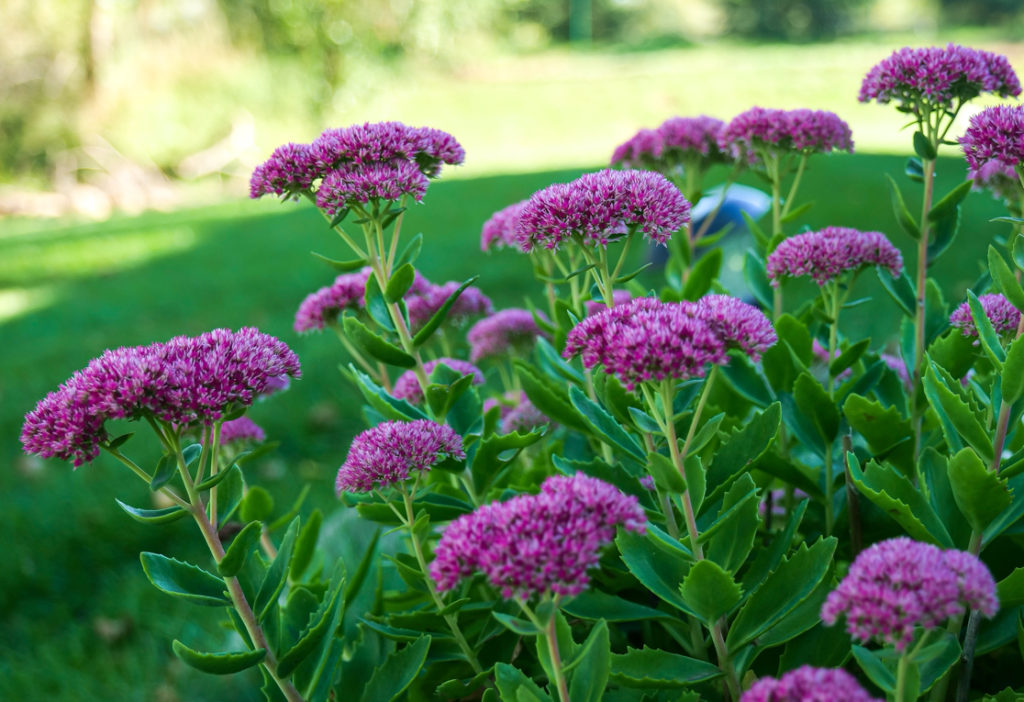
- COMMON NAME(S): Ice Plant
- HARDINESS RATING: H6
- PLANT TYPE: Perennial
- FOLIAGE TYPE: Deciduous
- FLOWERS: Pink
- FLOWERING SEASON(S): Summer
- SUNLIGHT: Full Sun
- EXPOSURE: Exposed
- SOIL PREFERENCE: Chalk, loam, sand; alkaline / neutral pH
- SIZE: 0.1-0.5m in height, 0.5-1m spread
A number of tender sub-tropical plants are also used as centrepieces for summer bedding schemes.
Cannas, or palms, for example, are popular choices.
Succulents are hugely popular right now and are often grown as houseplants, but in certain settings, these can also work well in summer bedding schemes.
For example, sedums can work very well for green roof or green wall planting displays over the summer months.
They can also work well in bed or border planting schemes in the right location, and also look very nice in pots and containers.
These can be combined with other succulents such as sempervivum and alpine plants like saxifrages, for example, to create interesting patterns in bedding displays.
10) Juniperus squamata
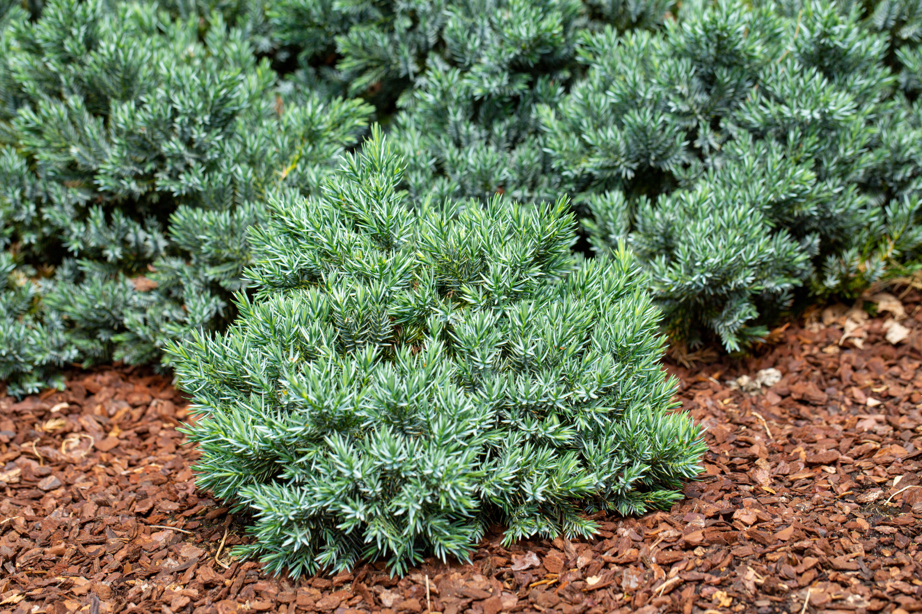
- COMMON NAME(S): Flaky Juniper
- HARDINESS RATING: H7
- PLANT TYPE: Shrub
- FOLIAGE TYPE: Evergreen
- SUNLIGHT: Full Sun / Partial Shade
- EXPOSURE: Exposed / Sheltered
- SOIL PREFERENCE: Any well-drained soil; any pH
- SIZE: 0.1-0.5m in height, 0.5-1m spread
It is also worthwhile considering adding shrubs or grasses which can also work well in containers, or provide a framework for larger bedding displays.
Low hedging or box shrubs can work well in creating formal bedding displays and ornamental grasses can work well as centrepieces or break up densely floral designs.
Our final bedding pick is a dwarf conifer Juniperus squamata, which can look great in mixed containers, or hold its own in a larger bedding scheme to show other bedding plants off to good effect in your displays.
Tips For Bedding Displays
Of course, the 10 bedding plants suited to displays that we have listed above only highlight the massive variety of plants which can be integrated into bedding displays throughout the year.
When it comes to creating effective and beautiful bedding displays, choosing ornamental plants is just part of the picture.
“For bedding displays, especially in pots, a good basis is to aim for thrillers, fillers and spillers,” shares Peter.
“I love to throw in a few statement thriller plants, such as dark leaf Cannas, or Cordylines, which can add height and drama to a display and need not be removed with the rest of the planting.
“Fillers are the mix of plants that make up the main mix of the display.

“If you can get hold of a colour wheel, colours either directly opposite or next to each other usually work best.
“Then, in pots, have a spiller to overflow the sides and hang down.
“In the open ground, maybe look to have an edging plant such as Jacobaea maritima ‘Silver Leaf.’ For me, this one frames a display nicely.”
To further help you in putting together your own bedding plant displays, here are some general tips:
- Decide upfront which type of bedding display you are going for. Do you want to create a formal scheme with orderly planting, or something more informal, for example? Will planting be looser, or are you aiming for an intricate and intensive carpet bedding design?
- Try wherever possible to sow and grow from scratch rather than buying in plug or bedding plants. This won’t just be more eco-friendly, it will save a lot of money too. Plant corms, rhizomes, bulbs and tubers in autumn or spring. Sow seeds under cover in late winter or early spring and plant out once all risk of frost has passed. Or direct sow hardy annuals in the ground early in the growing season. Take cuttings to expand your plant collection.
- Timing is important. Make sure you plant for a succession of blooms over as long a period as possible (which is better for wildlife as well as for you). Deadheading will prolong flowering for most plants.
- Make clear plans for your display, and make sure you know how many of each type of plant will be required to create the desired effect and cover the available space.
- Avoid overly ornate schemes with too many flowering plants. Mass or drift plantings of fewer species can sometimes be more effective than schemes that are too busy, with too many different species.
- Break up ‘old-fashioned’ floral displays with foliage plants to add texture and interest and make your bedding schemes more contemporary in feel.
- Consider integrating bedding schemes with food production. Gardens can be productive as well as beautiful. Many bedding plants can also be excellent companion plants for annual crops and fruits and vegetables can be attractive too – adding to the appeal as well as the utility of a seasonal display.
References
- 1Hopper, B. (2021, March 23). Digital Traineeship Blog: Postcards, Public Parks and Carpet Bedding. Garden Museum. Retrieved March 13, 2023, from https://gardenmuseum.org.uk/digital-traineeship-blog-postcards-public-parks-and-carpet-bedding/
